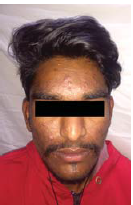Translate this page into:
SAPHO syndrome in a young male
[To cite: Singh K. SAPHO syndrome in a young male. Natl Med J India 2024;37:356. DOI: 10.25259/NMJI_1162_2023]
SAPHO (synovitis, acne, pustulosis, hyperostosis and osteitis) syndrome is a rare disease affecting young individuals. A young man presented with complaints of acne over the face (Fig. 1) and upper back for 2 months and chest pain for 7 days with a history of morning stiffness in the upper back. He also had intermittent pain in both knee joints for 1 year, along with pain in the gluteal regions. The non-contrast CT scan of the thorax showed diffuse sclerosis involving the sternum, manubrium, and medial end of bilateral clavicles (Fig. 2), periarticular erosions, and osteopenia involving bilateral sternoclavicular, bilateral sternochondral, and manubriosternal joints. Magnetic resonance imaging (MRI) showed bilateral sacroiliitis (Fig. 3). He responded well to a combination therapy of non-steroid anti-inflammatory drugs, corticosteroids, doxycycline, and topical benzoyl peroxide application over 15 days.

- Pustular acne over the face

- Non-contrast CT scan of the chest showing diffuse sclerosis of the sternum and medial ends of both clavicles (arrows)

- MRI of the lumbosacral region showing marked STIR hyperintensity involving iliac and sacral aspect of sacroiliac joint
SAPHO stands for synovitis, acne, pustulosis, hyperostosis, and osteitis and is a name given to a combination of inflammatory conditions involving the joints and characteristic skin lesions.1 Any affected bone segment will have osteitis and hyperostosis, which are noticeable characteristics. Bone lesions are manifested as severely painful and sometimes tender areas. The main affected area is the anterior chest wall, but the spine, pelvic girdle and extremities may also be affected. The aetiopathogenesis of SAPHO syndrome is still unknown. The infectious or post-infectious theory was long criticized but is now generating renewed interest. Several groups have found Propionibacterium acnes in osteoarticular lesions in the articular cartilage, which is known to cause acne and may also cause palmo-plantar pustulosis (PPP) and pyoderma gangrenosum.2,3 The disease tends to have a long course with remissions and relapses. The majority of patients have an indolent course. However, it occasionally develops into a serious illness that causes constant discomfort and a negative impact on overall health.
References
- The SAPHO syndrome: A single-center study of 41 adult patients. J Rheumatol. 2015;42:329-34.
- [CrossRef] [PubMed] [Google Scholar]
- Valuable lessons from SAPHO syndrome. Joint Bone Spine. 2007;74:123-6.
- [CrossRef] [PubMed] [Google Scholar]
- Propionibacterium acnes isolated from sternal osteitis in a patient with SAPHO syndrome. J Rheumatol. 1996;23:1302-4.
- [Google Scholar]




